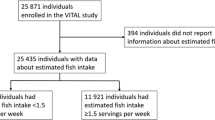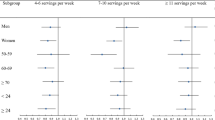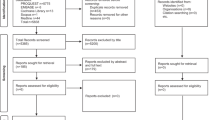Abstract
Objective: The present investigation was carried out to see whether intake of fish could influence infarct size as assessed by peak enzyme levels (CKmax and LDmax) as well as the occurrence of Q wave infarcts.
Design: The investigation was a prospectively planned cohort study.
Setting: The investigation was carried out at Ullevål University Hospital, Department of Cardiology and Department of Pharmacotherapeutics, University of Oslo, Oslo, and in four other Hospitals in Oslo and Lillehammer.
Subjects: Seven hundred and forty-five patients (median age 70 y, 64% males) admitted with proven acute myocardial infarction.
Results: Crude effects showed that the regression lines between the number of fish meals/week (FM/week) and CKmax in all patients and in the restricted cohorts of patients receiving/not receiving thrombolytic treatment were: y=2086-157·x(2P=0.004); y=2807-156·x (2P=0.110) and y=1260-54·x (2P=0.230); the corresponding results regarding LDmax were: y=1329-76·x (2P=0.009); y=1556-73·x (2P=0.120) and y=1047-39 x (2P=0.230). Odds ratio (OR) for developing Q wave infarcts in patients consuming >1.0 FM/week was 0.52, 95% confidence interval (CI) 0.34–0.79; 2P=0.001. For the adjusted effects, the coefficients of FM/week for log (peak enzyme levels) in all three groups of patients (all patients, and the restricted cohorts of patients receiving/not receiving thrombolytic treatment) were negative with 2P values of 0.014, 0.033 and 0.165 (CKmax), and 0.006, 0.033 and 0.158 (LDmax). OR for developing Q wave infarcts in patients consuming >1.0 FM/week was 0.59, 95% CI 0.38–0.92; 2P=0.022.
Conclusions: The results indicate that consuming fish may reduce infarct size as assessed by CKmax and LDmax as well as the occurrence of Q wave infarcts.
Sponsors: Department of Pharmacotherapeutics and Research Forum, Ullevål University Hospital
This is a preview of subscription content, access via your institution
Access options
Subscribe to this journal
Receive 12 print issues and online access
$259.00 per year
only $21.58 per issue
Buy this article
- Purchase on Springer Link
- Instant access to full article PDF
Prices may be subject to local taxes which are calculated during checkout
Similar content being viewed by others
Author information
Authors and Affiliations
Rights and permissions
About this article
Cite this article
Landmark, K., Abdelnoor, M., Kilhovd, B. et al. Eating fish may reduce infarct size and the occurrence of Q wave infarcts. Eur J Clin Nutr 52, 40–44 (1998). https://doi.org/10.1038/sj.ejcn.1600510
Received:
Revised:
Accepted:
Published:
Issue Date:
DOI: https://doi.org/10.1038/sj.ejcn.1600510



